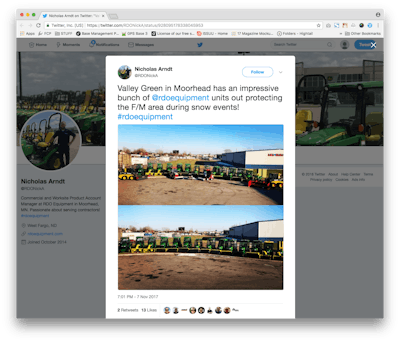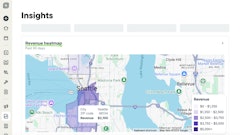
Social media’s emergence as a business opportunity in the last decade has given many companies the chance to determine how it fit with their sales, marketing and communications efforts. Early on, some jumped on board with Facebook, a handful were excited to tweet and others were among the first to share photos on Instagram.
Today, most businesses are present on at least one social media channel, with the most social-savvy companies being able to measure and place value on their efforts. But looking outside of metrics, social media’s real power is in how it became a space where people engage with other people to create and build relationships. As companies realized the benefits of these personal connections, some began evolving traditional social media strategies into employee-focused and -driven efforts known as social employee advocacy programs. RDO Equipment Company was one of them.
Getting Social
About two years ago, RDO Equipment launched an employee social advocacy program on Twitter, encouraging team members to have unique voices and connect with others on social media as representatives of the business and brand.
Programs like this are growing. Research obtained and shared by MarketingProfs in 2017 shows interest in employee advocacy increased 191 percent from 2013 to 2015, and today, 90 percent of brands report they are pursuing some type of employee advocacy program.
RDO Equipment Company’s social employees—in particular, its agriculture-, lawn and garden- and tree care-focused team members—are great examples of how key areas like culture, engagement and the bottom line can benefit from employee social advocacy programs.
Culture Boost
One of the top goals companies have with employee social advocacy programs is to showcase their unique culture. While every business can claim it has a great culture, employees who show it are the proof.
Showcasing culture is great for employee recruiting and retention, establishing the company in the community, and presenting the company as one with which others would want to do business.
Engagement Avenue
Closely related to culture, employee engagement improves with social advocacy programs. And this isn’t just on social media, where employees engage with peers, businesses and the community. Research from numerous sources, including the Edelman Trust Barometer, shows that, when employees are empowered to be ambassadors, they feel trusted and like a part of the company’s success, and therefore, more engaged in their jobs and the company.
Engagement is a two-way street, with employee social advocacy programs also offering opportunities for external audiences to engage with brands. In 2016, organic reach on Facebook fell 52 percent—but social-savvy companies are finding ways to combat this trend. MarketingProfs research shows content shared by employees receives eight times more engagement than the same content shared by brands and LinkedIn states that employee sharing helps generate two times more click-throughs on content.
Employee advocacy programs also build on a newer engagement trend—micro-influencers. Traditionally, many social media marketing strategies were based around big influencers, for example, people with tens of thousands or even a million followers on Instagram or Twitter. Micro-influencers are the same as big influencers in terms of how they engage and share content that promotes a brand, but it’s done on a smaller scale, for example, people with 100 followers. Micro-influencers can have a big impact and attract the attention of large brands.
One of the biggest advantages with micro-influencers, and especially relevant in a company’s employee advocacy setting, is they’re specialized and credible in their area of expertise. Therefore, they have very relevant, engaged audiences.
Business Advantage
While culture and engagement are crucial for successful companies, the bottom line matters, too. Good news for employee social advocacy programs is they can directly benefit the business, and its sales, marketing and public relations efforts.
Nearly everyone knows the saying, “People don’t do business with businesses; people do business with people.” Tying people, faces and names to the business adds a person-to-person connection versus person-to-business, and humanizes the brand.
Nick Arndt is an account manager at RDO Equipment. Rather than use his Twitter account to blast messages of reduced prices and great financing offers, he shares videos of close-up machine features and first looks at new equipment. Most importantly, he uses Twitter to showcase his customers and the equipment solutions he’s able to provide.
While true in the social sense, business-to-business (B2B) organizations still have distinct buyers and markets, and characteristics that make them operate differently than business-to-consumer (B2C) companies. Employee social advocacy offers advantages here, too.
For example, compared to B2C, the buying cycle in B2B markets is much longer, markets are smaller and more focused, and customers do more research and have more challenges when making purchases. Relationship-building, engagement and demonstrating expertise achieved through employee advocacy can be big game-changers in nurturing these potential customers from interest to final purchase. RDO product specialist Ben Hilde saw one of his tweets do just that.
After sharing a tweet about a sprayer, an interested follower liked it, then asked about it at his local RDO Equipment Company store. After trying it, the customer ended up leasing it—then, more than a year after Hilde’s initial tweet, shared his own photo of it in action on Twitter.
Finally, events and trade shows offer another avenue to connect social employees with potential customers. Many events have social accounts employees can follow and start to connect with others who are linked to the event even before it begins. Most events have a special hashtag, too, allowing employees to join others in the conversation by tweeting photos or great quotes from presenters. They can even share relevant content from their organization on the topic.
Chris Stanley, an account manager for RDO Vermeer, was one of the first social employees to create an RDO-branded Instagram account. His photos and videos from last November’s Tree Care Industry (TCI) Expo received a lot of engagement and numerous comments, including from other attendees—a great opportunity to connect with current and potential customers created from an employee social advocacy program and a few simple posts.
The benefits of employee social advocacy programs are clear both internally and externally. By sharing quality content, engaging people to create and build relationships, and representing the company with unique voices, employee advocates can be a great complement to a company’s social media strategy.
Four Tips to Start a Successful Employee Social Advocacy Program
Tip 1: Identify a person or team to lead an employee social advocacy program. The person or team should be responsible for everything from initial employee training to ongoing program monitoring.
Tip 2: Help employees identify culture moments that would make great social posts—a thank you to a coworker, a photo of the team’s volunteer effort or a link to an article to which they contributed input.
Tip 3: Coach employees to connect with people, businesses and companies important to their work so they can begin following, engaging and building a relevant audience.
Tip 4: To establish a connection to the company and brand, have employees create consistent social handles that tie in the company name and include the company’s handle in their profile.















![Gravely Pro Turn Mach One My23 Dsc03139 Edit 1200x800 5b2df79[1]](https://img.greenindustrypros.com/mindful/acbm/workspaces/default/uploads/2025/10/gravely-pro-turn-mach-one-my23-dsc03139-edit-1200x800-5b2df791.BucBnDoN22.jpg?ar=16%3A9&auto=format%2Ccompress&fit=crop&h=135&q=70&w=240)



